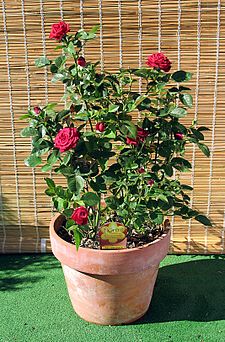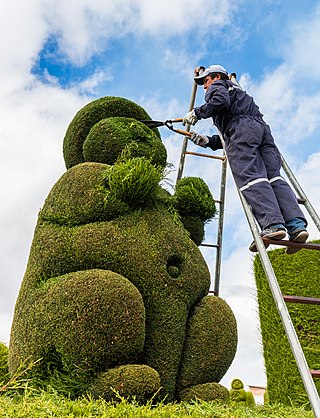
Gardening is the process of growing plants for their vegetables, fruits, flowers, herbs, and appearances within a designated space. Gardens fulfill a wide assortment of purposes, notably the production of aesthetically pleasing areas, medicines, cosmetics, dyes, foods, poisons, wildlife habitats, and saleable goods. People often partake in gardening for its therapeutic, health, educational, cultural, philosophical, environmental, and religious benefits.

The Japanese beetle is a species of scarab beetle. Due to the presence of natural predators, the Japanese beetle is not considered a pest in its native Japan, but in North America and some regions of Europe, it is a noted pest to roughly 300 species of plants. Some of these plants include rose bushes, grapes, hops, canna, crape myrtles, birch trees, linden trees, and others.

Groundcover or ground cover is any plant that grows over an area of ground. Groundcover provides protection of the topsoil from erosion and drought.

Horticulture is the art and science of growing plants. This definition is seen in its etymology, which is derived from the Latin words hortus, which means "garden" and cultura which means "to cultivate". There are various divisions of horticulture because plants are grown for a variety of purposes. These divisions include, but are not limited to: gardening, plant production/propagation, arboriculture, landscaping, floriculture and turf maintenance. For each of these, there are various professions, aspects, tools used and associated challenges; Each requiring highly specialized skills and knowledge of the horticulturist.

In botany, a perennial plant or simply perennial is a plant that lives more than two years. The term is often used to differentiate a plant from shorter-lived annuals and biennials. The term is also widely used to distinguish plants with little or no woody growth from trees and shrubs, which are also technically perennials. Notably, it is estimated that 94% of plant species fall under the category of perennials, underscoring the prevalence of plants with lifespans exceeding two years in the botanical world.
Garden design is the art and process of designing and creating plans for layout and planting of gardens and landscapes. Garden design may be done by the garden owner themselves, or by professionals of varying levels of experience and expertise. Most professional garden designers have some training in horticulture and the principles of design. Some are also landscape architects, a more formal level of training that usually requires an advanced degree and often a state license. Amateur gardeners may also attain a high level of experience from extensive hours working in their own gardens, through casual study, serious study in Master gardener programs, or by joining gardening clubs.
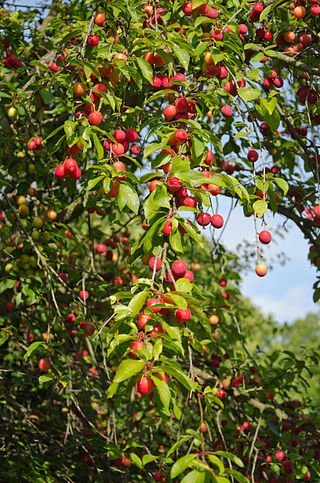
Prunus cerasifera is a species of plum known by the common names cherry plum and myrobalan plum. It is native to Southeast Europe and Western Asia, and is naturalised in the British Isles and scattered locations in North America. Also naturalized in parts of SE Australia where it is considered to be a mildly invasive weed of bushland near urban centers. P. cerasifera is believed to one of the parents of the Cultivated Plum, Prunus domestica perhaps crossing with the sloe, Prunus spinosa, or perhaps the sole parent. This would make it a parent of most of the commercial varieties of plum in the UK and mainland Europe - Victoria, greengages, bullace etc.

Ornamental grasses are grasses grown as ornamental plants. Ornamental grasses are popular in many colder hardiness zones for their resilience to cold temperatures and aesthetic value throughout fall and winter seasons.

The Harry P. Leu Gardens are semi-tropical and tropical gardens in Orlando, Florida, United States. The gardens contain nearly 50 acres (200,000 m2) of landscaped grounds and lakes, with trails shaded by 200-year-old oaks and forests of camellias. They are open to the public. The address is 1920 North Forest Avenue Orlando, FL 32803.

The cottage garden is a distinct style that uses informal design, traditional materials, dense plantings, and a mixture of ornamental and edible plants. English in origin, it depends on grace and charm rather than grandeur and formal structure. Homely and functional gardens connected to cottages go back centuries, but their stylized reinvention occurred in 1870s England, as a reaction to the more structured, rigorously maintained estate gardens with their formal designs and mass plantings of greenhouse annuals.

Lavandula angustifolia, formerly L. officinalis, is a flowering plant in the family Lamiaceae, native to the Mediterranean. Its common names include lavender, true lavender and English lavender ; also garden lavender, common lavender and narrow-leaved lavender.
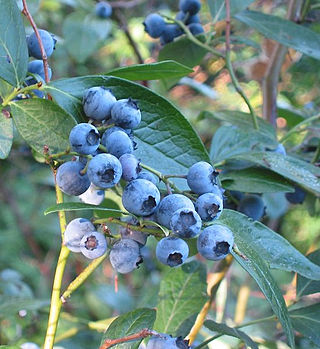
Vaccinium corymbosum, the northern highbush blueberry, is a North American species of blueberry which has become a food crop of significant economic importance. It is native to eastern Canada and the eastern and southern United States, from Ontario east to Nova Scotia and south as far as Florida and eastern Texas. It is also naturalized in other places: Europe, Japan, New Zealand, the Pacific Northwest of North America, etc. Other common names include blue huckleberry, tall huckleberry, swamp huckleberry, high blueberry, and swamp blueberry.
This is an alphabetical index of articles related to gardening.

The traditional kitchen garden, vegetable garden, also known as a potager or in Scotland a kailyaird, is a space separate from the rest of the residential garden – the ornamental plants and lawn areas. It is used for growing edible plants and often some medicinal plants, especially historically. The plants are grown for domestic use; though some seasonal surpluses are given away or sold, a commercial operation growing a variety of vegetables is more commonly termed a market garden. The kitchen garden is different not only in its history, but also its functional design. It differs from an allotment in that a kitchen garden is on private land attached or very close to the dwelling. It is regarded as essential that the kitchen garden could be quickly accessed by the cook.

The floral industry is focused on the production, distribution and sale of flowers for human enjoyment. The floral industry began in the Golden Century of the Netherlands, where flowers were grown on a large scale on vast estates. The industry continues to diversify from the production of cut flowers to the production and sale of plants and flowers in many different forms. The global floral industry market size is estimated to be worth US$ 50040 million in 2022 and is forecast to increase to US$ 58030 million by 2028 with a compound annual growth rate of 2.5% during the review period.

The American Elm cultivar Ulmus americana 'Princeton' was originally selected in 1922 by New Jersey nurseryman William Flemer of Princeton Nurseries for its aesthetic merit. 'Princeton' was later found to have a moderate resistance to Dutch elm disease (DED).
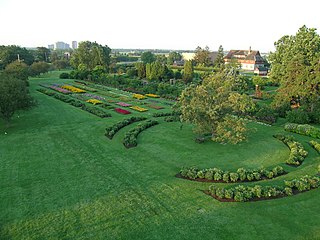
The Ornamental Gardens are an agricultural facility that emphasizes research, education, and beauty as part of Agriculture and Agri-Food Canada's Central Experimental Farm. As the name indicates, the gardens are centrally located in and now surrounded by the city of Ottawa, Ontario, Canada. The 8 acres garden is a National Historic Site and Cultural Heritage Landscape.

Liriope muscari is a species of flowering plant from East Asia. Common names in English include big blue lilyturf, lilyturf, border grass, and monkey grass. This small herbaceous perennial has grass-like evergreen foliage and lilac-purple flowers which produce single-seeded berries on a spike in the fall. It is invasive to North America and considered a threat to native wildlife.

Celtica gigantea, commonly called giant feather grass, giant needle grass, or golden oats, is a species of flowering plant in the grass family Poaceae, native to the Iberian Peninsula and Morocco. It is still widely referenced in the horticultural literature under its synonym Stipa gigantea.

Foodscaping is a modern term for the practice of integrating edible plants into ornamental landscapes. It is also referred to as edible landscaping and has been described as a crossbreed between landscaping and farming. As an ideology, foodscaping aims to show that edible plants are not only consumable but can also be appreciated for their aesthetic qualities. Foodscaping spaces are seen as multi-functional landscapes which are visually attractive and also provide edible returns. Foodscaping is a great way to provide fresh food in an affordable way.


